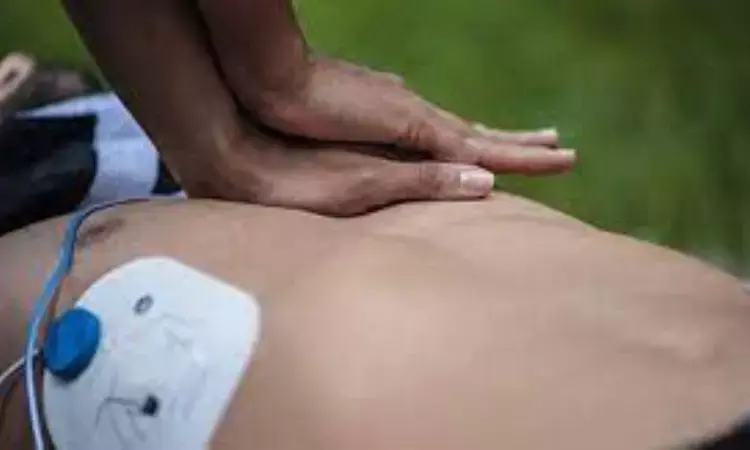- Home
- Medical news & Guidelines
- Anesthesiology
- Cardiology and CTVS
- Critical Care
- Dentistry
- Dermatology
- Diabetes and Endocrinology
- ENT
- Gastroenterology
- Medicine
- Nephrology
- Neurology
- Obstretics-Gynaecology
- Oncology
- Ophthalmology
- Orthopaedics
- Pediatrics-Neonatology
- Psychiatry
- Pulmonology
- Radiology
- Surgery
- Urology
- Laboratory Medicine
- Diet
- Nursing
- Paramedical
- Physiotherapy
- Health news
- Fact Check
- Bone Health Fact Check
- Brain Health Fact Check
- Cancer Related Fact Check
- Child Care Fact Check
- Dental and oral health fact check
- Diabetes and metabolic health fact check
- Diet and Nutrition Fact Check
- Eye and ENT Care Fact Check
- Fitness fact check
- Gut health fact check
- Heart health fact check
- Kidney health fact check
- Medical education fact check
- Men's health fact check
- Respiratory fact check
- Skin and hair care fact check
- Vaccine and Immunization fact check
- Women's health fact check
- AYUSH
- State News
- Andaman and Nicobar Islands
- Andhra Pradesh
- Arunachal Pradesh
- Assam
- Bihar
- Chandigarh
- Chattisgarh
- Dadra and Nagar Haveli
- Daman and Diu
- Delhi
- Goa
- Gujarat
- Haryana
- Himachal Pradesh
- Jammu & Kashmir
- Jharkhand
- Karnataka
- Kerala
- Ladakh
- Lakshadweep
- Madhya Pradesh
- Maharashtra
- Manipur
- Meghalaya
- Mizoram
- Nagaland
- Odisha
- Puducherry
- Punjab
- Rajasthan
- Sikkim
- Tamil Nadu
- Telangana
- Tripura
- Uttar Pradesh
- Uttrakhand
- West Bengal
- Medical Education
- Industry
Incidence of in hospital cardiac Arrest may peak during winter season

Muddasir Ashraf and team unveiled compelling evidence of seasonal variation in the incidence of in-hospital cardiac arrest (IHCA) in a comprehensive study using National Inpatient Sample data spanning from 2005 to 2019. The findings published in the JACC: Clinical Electrophysiology suggest that IHCA rates are notably higher during the winter months, shedding light on potential strategies for early recognition and improved patient care.
The study, conducted over a 14-year period, aimed to scrutinize the seasonal differences in IHCA incidence and associated mortality. Researchers divided the data into four seasons and stratified the results by sex, age, and region. Their secondary goal was to identify the primary causes of admission leading to IHCA, differences between shockable and nonshockable IHCA cases, independent predictors of IHCA, and variations in IHCA-related in-hospital mortality and length of stay.
One of the most striking findings was a consistent peak in IHCA incidents during the winter season across all demographic groups and regions. This seasonal trend persisted over the years and was evident in both male and female patients, with the exception of those under 45 years old. In 2019, the study reported higher unadjusted and risk-adjusted odds of IHCA during the winter season compared to summer (odds ratio: 1.13; adjusted odds ratio: 1.08).
The study revealed that patients experiencing shockable IHCA were predominantly admitted for cardiac-related issues, whereas nonshockable IHCA cases were linked to noncardiac conditions. This distinction underscores the importance of targeted preventive measures and care strategies based on the nature of the underlying health condition.
Interestingly, despite the seasonal fluctuations in IHCA incidence, no significant seasonal variation was observed in in-hospital mortality rates following IHCA. This suggests that the care and treatment provided during IHCA events remain consistent throughout the year, yielding similar outcomes regardless of the season.
Understanding the higher incidence of IHCA during winter may aid in better resource allocation and the development of strategies for early identification of individuals at risk for IHCA. Closer monitoring and optimization of care during the winter months can also be explored to mitigate the impact of this seasonal trend on patient outcomes.
Source:
Ashraf, M., Sulaiman, S., Alyami, B., Bhatia, A., & Jahangir, A. (2023). Seasonal Variation in the Incidence of In-Hospital Cardiac Arrest. In JACC: Clinical Electrophysiology (Vol. 9, Issue 8, pp. 1755–1767). Elsevier BV. https://doi.org/10.1016/j.jacep.2023.04.012
Neuroscience Masters graduate
Jacinthlyn Sylvia, a Neuroscience Master's graduate from Chennai has worked extensively in deciphering the neurobiology of cognition and motor control in aging. She also has spread-out exposure to Neurosurgery from her Bachelor’s. She is currently involved in active Neuro-Oncology research. She is an upcoming neuroscientist with a fiery passion for writing. Her news cover at Medical Dialogues feature recent discoveries and updates from the healthcare and biomedical research fields. She can be reached at editorial@medicaldialogues.in
Dr Kamal Kant Kohli-MBBS, DTCD- a chest specialist with more than 30 years of practice and a flair for writing clinical articles, Dr Kamal Kant Kohli joined Medical Dialogues as a Chief Editor of Medical News. Besides writing articles, as an editor, he proofreads and verifies all the medical content published on Medical Dialogues including those coming from journals, studies,medical conferences,guidelines etc. Email: drkohli@medicaldialogues.in. Contact no. 011-43720751


